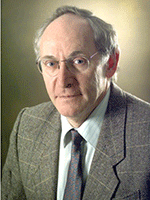 Hugh Isaacs was a passionate ambassador for electrochemical science and engineering and was a leading figure in the corrosion community for over four decades. He was a member of ECS since 1967 and also recognized as an ECS fellow. He passed away on Long Island on December 5, 2016. He is survived by his wife, Sheila, and his children, Darryl and Claire, his son-in-law, Robert, and two granddaughters.
Hugh Isaacs was a passionate ambassador for electrochemical science and engineering and was a leading figure in the corrosion community for over four decades. He was a member of ECS since 1967 and also recognized as an ECS fellow. He passed away on Long Island on December 5, 2016. He is survived by his wife, Sheila, and his children, Darryl and Claire, his son-in-law, Robert, and two granddaughters.
Dr. Isaacs obtained his bachelor’s degree in metallurgy from The University of Witwatersrand in his native South Africa, and then moved to Imperial College London, where he obtained a diploma in nuclear engineering, and a PhD in metallurgy in 1963. His doctoral work was his first foray into electrochemistry, working with molten salt-metal systems.
Following the completion of his studies, Dr. Isaacs worked at the Atomic Energy Research Establishment at Harwell and then for the South African Atomic Energy Board in Pretoria, continuing his work in high temperature electrochemistry. In 1967, he moved to the Department of Applied Science at Brookhaven National Laboratory where, with a brief period at Oak Ridge National Laboratory (1972-1974), he was to spend the rest of his professional life.
Dr. Isaacs made seminal contributions to the field of localized corrosion, and was a key innovator in the application of new techniques, notably in the use of synchrotron radiation to study localized dissolution processes and in scanning electrochemical systems to map surface reactivity. Dr. Isaacs published over 130 papers, 45 of which appeared in the Journal of The Electrochemical Society. He was the recipient of numerous prestigious awards including an Outstanding Achievement Award, U.S. Department of Energy (1983); the Sam Tour Award, Corrosion Section, ASTM (1983); H. H. Uhlig Award of The Electrochemical Society (1993); and the W. R. Whitney Award from NACE International (2000). Before he passed, Dr. Isaacs was confirmed as the latest awardee of the UK Institute of Corrosion U. R. Evans Award, which will be awarded posthumously in 2017.
Dr. Isaacs will be remembered by all who knew him as a quiet and modest, but inspirational colleague, generous with both his time and ideas. He mentored many postdocs from around the world as well as students from Stony Brook University. He always had time to talk to anyone about corrosion, from longtime colleagues to graduate students he just met. Beyond his tremendous scientific contributions, Hugh enjoyed art, both painting and sculpture, and was a life-long runner, and even joined his wife in several triathlons.
